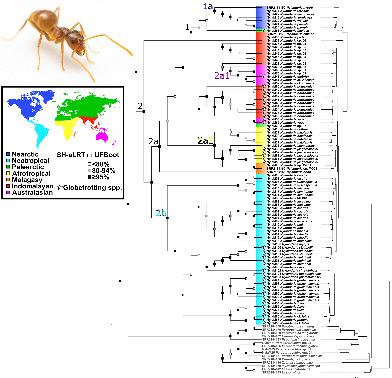当前位置:
X-MOL 学术
›
Syst. Entomol.
›
论文详情
Our official English website, www.x-mol.net, welcomes your
feedback! (Note: you will need to create a separate account there.)
Global domination by crazy ants: phylogenomics reveals biogeographical history and invasive species relationships in the genus Nylanderia (Hymenoptera: Formicidae)
Systematic Entomology ( IF 4.7 ) Pub Date : 2020-01-31 , DOI: 10.1111/syen.12423 Jason L. Williams 1 , Yuanmeng Miles Zhang 1 , Michael W. Lloyd 2, 3 , John S. LaPolla 4 , Ted R. Schultz 2 , Andrea Lucky 1
Systematic Entomology ( IF 4.7 ) Pub Date : 2020-01-31 , DOI: 10.1111/syen.12423 Jason L. Williams 1 , Yuanmeng Miles Zhang 1 , Michael W. Lloyd 2, 3 , John S. LaPolla 4 , Ted R. Schultz 2 , Andrea Lucky 1
Affiliation

|
Nylanderia (Emery) is one of the world's most diverse ant genera, with 123 described species worldwide and hundreds more undescribed. Fifteen globetrotting or invasive species have widespread distributions and are often encountered outside their native ranges. A molecular approach to understanding the evolutionary history and to revision of Nylanderia taxonomy is needed because historical efforts based on morphology have proven insufficient to define major lineages and delimit species boundaries, especially where adventive species are concerned. To address these problems, we generated the first genus‐wide genomic dataset of Nylanderia using ultraconserved elements (UCEs) to resolve the phylogeny of major lineages, determine the age and origin of the genus, and describe global biogeographical patterns. Sampling from seven biogeographical regions revealed a Southeast Asian origin of Nylanderia in the mid‐Eocene and four distinct biogeographical clades in the Nearctic, the Neotropics, the Afrotropics/Malagasy region, and Australasia. The Nearctic and Neotropical clades are distantly related, indicating two separate dispersal events to the Americas between the late Oligocene and early Miocene. We also addressed the problem of misidentification that has characterized species‐level taxonomy in Nylanderia as a result of limited morphological variation in the worker caste by evaluating the integrity of species boundaries in six of the most widespread Nylanderia species. We sampled across ranges of species in the N. bourbonica complex (N. bourbonica (Forel) + N. vaga (Forel)), the N. fulva complex (N. fulva (Mayr) + N. pubens (Forel)), and the N. guatemalensis complex (N. guatemalensis (Forel) + N. steinheili (Forel)) to clarify their phylogenetic placement. Deep splits within these complexes suggest that some species names – specifically N. bourbonica and N. guatemalensis – each are applied to multiple cryptic species. In exhaustively sampling Nylanderia diversity in the West Indies, a ‘hot spot’ for invasive taxa, we found five adventive species among 22 in the region; many remain morphologically indistinguishable from one another, despite being distantly related. We stress that overcoming the taxonomic impediment through the use of molecular phylogeny and revisionary study is essential for conservation and invasive species management.
中文翻译:

疯狂蚂蚁的全球统治:系统基因组学揭示了 Nylanderia 属(膜翅目:蚁科)的生物地理历史和入侵物种关系
Nylanderia (Emery) 是世界上最多样化的蚂蚁属之一,全世界有 123 种被描述的物种,还有数百种未被描述。有 15 种环球旅行或入侵物种分布广泛,经常在其原生范围之外遇到。需要一种了解进化历史和修订 Nylanderia 分类法的分子方法,因为基于形态学的历史努力已被证明不足以定义主要谱系和划定物种边界,尤其是在涉及外来物种的情况下。为了解决这些问题,我们使用超保守元素 (UCE) 生成了 Nylanderia 的第一个全属基因组数据集,以解决主要谱系的系统发育问题,确定该属的年龄和起源,并描述全球生物地理模式。来自七个生物地理区域的采样显示,Nylanderia 起源于中始新世的东南亚,以及近北、新热带、非洲热带/马达加斯加地区和澳大拉西亚的四个不同的生物地理进化枝。Nearctic 和 Neotropical 进化枝是远缘关系,表明在渐新世晚期和中新世早期之间有两个独立的传播事件到美洲。我们还通过评估六个最广泛的 Nylanderia 物种的物种边界的完整性,解决了由于工人种姓的形态变异有限而导致 Nylanderia 物种级分类学特征的错误识别问题。我们对波旁猪笼草复合体(N. bourbonica (Forel) + N. vaga (Forel))、黄花性猪笼草复合体(N. fulva (Mayr) + N. pubens (Forel))中的物种范围进行了采样,以及然后。guatemalensis complex (N. Guatemalensis (Forel) + N. steinheili (Forel)) 来阐明它们的系统发育位置。这些复合体中的深度分裂表明,某些物种名称——特别是波旁猪笼草和危地马拉猪笼草——每个都适用于多个隐秘物种。在对西印度群岛的 Nylanderia 多样性进行详尽抽样时,我们发现了该地区 22 个物种中的 5 个外来物种;尽管有远亲关系,但许多在形态上仍然无法区分。我们强调,通过使用分子系统发育和修正研究克服分类障碍对于保护和入侵物种管理至关重要。这些复合体中的深度分裂表明,某些物种名称——特别是波旁猪笼草和危地马拉猪笼草——每个都适用于多个隐秘物种。在对西印度群岛的 Nylanderia 多样性进行详尽抽样时,我们发现了该地区 22 个物种中的 5 个外来物种;尽管有远亲关系,但许多在形态上仍然无法区分。我们强调,通过使用分子系统发育和修正研究克服分类障碍对于保护和入侵物种管理至关重要。这些复合体中的深度分裂表明,某些物种名称——特别是波旁猪笼草和危地马拉猪笼草——每个都适用于多个隐秘物种。在对西印度群岛的 Nylanderia 多样性进行详尽抽样时,我们发现了该地区 22 个物种中的 5 个外来物种;尽管有远亲关系,但许多在形态上仍然无法区分。我们强调,通过使用分子系统发育和修正研究克服分类障碍对于保护和入侵物种管理至关重要。我们在该地区的 22 个物种中发现了 5 个外来物种;尽管有远亲关系,但许多在形态上仍然无法区分。我们强调,通过使用分子系统发育和修正研究克服分类障碍对于保护和入侵物种管理至关重要。我们在该地区的 22 个物种中发现了 5 个外来物种;尽管有远亲关系,但许多在形态上仍然无法区分。我们强调,通过使用分子系统发育和修正研究克服分类障碍对于保护和入侵物种管理至关重要。
更新日期:2020-01-31
中文翻译:

疯狂蚂蚁的全球统治:系统基因组学揭示了 Nylanderia 属(膜翅目:蚁科)的生物地理历史和入侵物种关系
Nylanderia (Emery) 是世界上最多样化的蚂蚁属之一,全世界有 123 种被描述的物种,还有数百种未被描述。有 15 种环球旅行或入侵物种分布广泛,经常在其原生范围之外遇到。需要一种了解进化历史和修订 Nylanderia 分类法的分子方法,因为基于形态学的历史努力已被证明不足以定义主要谱系和划定物种边界,尤其是在涉及外来物种的情况下。为了解决这些问题,我们使用超保守元素 (UCE) 生成了 Nylanderia 的第一个全属基因组数据集,以解决主要谱系的系统发育问题,确定该属的年龄和起源,并描述全球生物地理模式。来自七个生物地理区域的采样显示,Nylanderia 起源于中始新世的东南亚,以及近北、新热带、非洲热带/马达加斯加地区和澳大拉西亚的四个不同的生物地理进化枝。Nearctic 和 Neotropical 进化枝是远缘关系,表明在渐新世晚期和中新世早期之间有两个独立的传播事件到美洲。我们还通过评估六个最广泛的 Nylanderia 物种的物种边界的完整性,解决了由于工人种姓的形态变异有限而导致 Nylanderia 物种级分类学特征的错误识别问题。我们对波旁猪笼草复合体(N. bourbonica (Forel) + N. vaga (Forel))、黄花性猪笼草复合体(N. fulva (Mayr) + N. pubens (Forel))中的物种范围进行了采样,以及然后。guatemalensis complex (N. Guatemalensis (Forel) + N. steinheili (Forel)) 来阐明它们的系统发育位置。这些复合体中的深度分裂表明,某些物种名称——特别是波旁猪笼草和危地马拉猪笼草——每个都适用于多个隐秘物种。在对西印度群岛的 Nylanderia 多样性进行详尽抽样时,我们发现了该地区 22 个物种中的 5 个外来物种;尽管有远亲关系,但许多在形态上仍然无法区分。我们强调,通过使用分子系统发育和修正研究克服分类障碍对于保护和入侵物种管理至关重要。这些复合体中的深度分裂表明,某些物种名称——特别是波旁猪笼草和危地马拉猪笼草——每个都适用于多个隐秘物种。在对西印度群岛的 Nylanderia 多样性进行详尽抽样时,我们发现了该地区 22 个物种中的 5 个外来物种;尽管有远亲关系,但许多在形态上仍然无法区分。我们强调,通过使用分子系统发育和修正研究克服分类障碍对于保护和入侵物种管理至关重要。这些复合体中的深度分裂表明,某些物种名称——特别是波旁猪笼草和危地马拉猪笼草——每个都适用于多个隐秘物种。在对西印度群岛的 Nylanderia 多样性进行详尽抽样时,我们发现了该地区 22 个物种中的 5 个外来物种;尽管有远亲关系,但许多在形态上仍然无法区分。我们强调,通过使用分子系统发育和修正研究克服分类障碍对于保护和入侵物种管理至关重要。我们在该地区的 22 个物种中发现了 5 个外来物种;尽管有远亲关系,但许多在形态上仍然无法区分。我们强调,通过使用分子系统发育和修正研究克服分类障碍对于保护和入侵物种管理至关重要。我们在该地区的 22 个物种中发现了 5 个外来物种;尽管有远亲关系,但许多在形态上仍然无法区分。我们强调,通过使用分子系统发育和修正研究克服分类障碍对于保护和入侵物种管理至关重要。











































 京公网安备 11010802027423号
京公网安备 11010802027423号